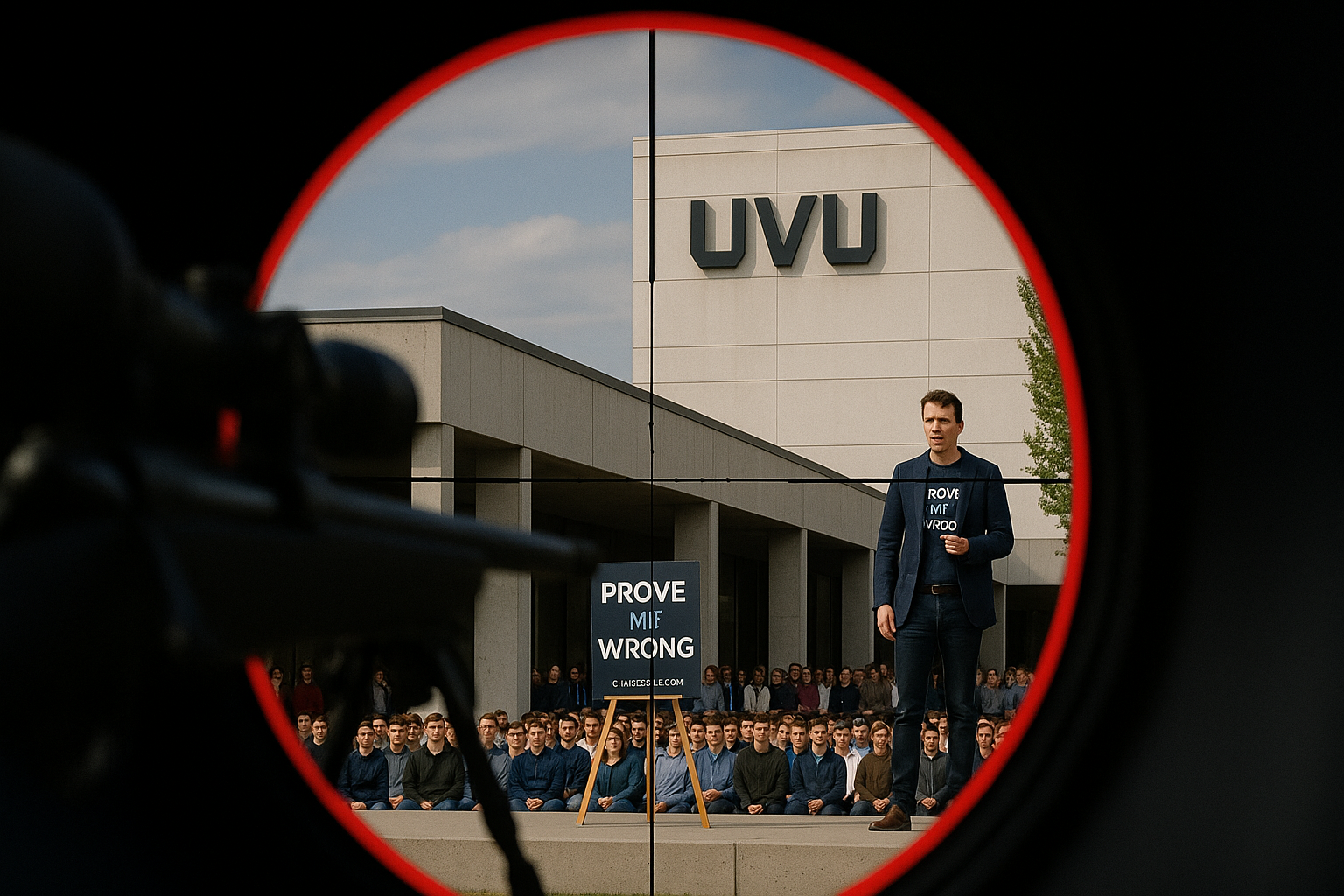The Shot from the Rooftop:
Tracing the Assassin’s Path
written by
jaron summers (c) 2025
It took one bullet.
One carefully placed shot from a rooftop at Utah Valley University ended the life of Charlie Kirk, the conservative firebrand speaker, in front of hundreds of witnesses gathered for one of his signature “Prove Me Wrong” events.
The New York Times, without hesitation, labeled the shooter an assassin. The word landed with weight—evoking images of shadowy figures, cloaked motivations, and calculated murder.
A Killing With Clues, But No Name
⊕ Rifle recovered: a bolt-action weapon believed to be the murder weapon.
⊕ Surveillance footage: a person in dark clothing climbing to the roof and fleeing.
⊕ Engraved ammunition: bullets bore ideologically charged messages.
⊕ One shot, one kill: no crossfire, no collateral damage.
Assassin or Amateur?
Was this a professional hit? Or was the shooter an ideologue, self-radicalized and symbolic?
In nearly every mob hit, the assassin leaves the weapon behind. It’s a calling card—but also a safeguard. No pro wants to be caught with the murder weapon during a random stop. This tradition may explain the rifle’s abandonment.
Most Likely: Ideological Lone Wolf
Estimated likelihood: 45%. Motivated by ideology, not money. The bullets were meant to say something. This is the modern political vigilante.
Possible: Professional Assassin
Estimated likelihood: 20%. Tactical execution suggests training. But the dramatic inscriptions on the bullets suggest message over money.
Extremist Cell or Group
Estimated likelihood: 15%. A coordinated hit? Maybe. But no claims of responsibility have emerged.
The Word That Started It All: Assassin
The word “assassin” comes from the Hashashin, a sect of 11th-century Ismailis known for targeted political killings. Crusaders brought the legend back to Europe, where the term took root—forever linking politics and murder.
Historical depiction of Hashashin—legendary political killers of Persia and Syria.
The Thuggee Connection
The Thuggee cult of India preyed on travelers in the name of Kali. From their rituals, we get the modern word thug. Less political, more brutal—but no less organized.
Odds of Capture
With surveillance footage, forensics, and digital tracking, the odds of arrest are strong: 75–85%. Federal and local agencies are working around the clock. The killer may already be known to someone. The pressure is mounting.
Key Takeaway: This was no random act. It was targeted, symbolic, and deliberate. Whether the killer wore a cloak or a hoodie, they’ve joined the ancient ranks of the assassin.
One man stood at a podium. Another, above him, with a rifle. The shot that rang out was not just a bullet. It was a message—and someone, somewhere, wanted it heard.
Kirk’s death was tragic in so many ways. The assassin destroyed a man who taught millions, especially young men, that they could debate with grace
Kirk’s death was tragic in many ways. The assassin didn’t just silence a voice — he pulled the plug on a one-man power plant of provocative thought, viral logic, and unapologetic eyebrow-raising.
With one bullet, he killed a man who taught millions — especially young men — that disagreement wasn’t a war crime, and that debate could come with a grin, not a growl.
Charlie Kirk showed that you could toss verbal grenades and still shake hands afterward—that you could battle ideas without bayoneting your opponent. He made political theater look more like stand-up courtship than trench warfare.
Did Charlie Kirk make mistakes? Was he a racist? Did he stretch the truth? Was he a bully? Here is what chatGPT reports: https://chatgpt.com/c/68c4168e-b570-8324-bf3c-479239c9be76
I can see nothing that he did or said that he deserved to die for.
And now, tragically, he’s gone. Shot down not by a better argument, but by the worst possible answer: a coward with a scope.
The irony? The man who said, “Prove Me Wrong” was silenced by someone too afraid to try.

